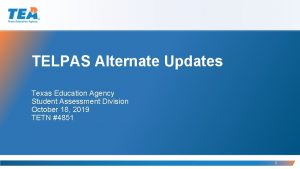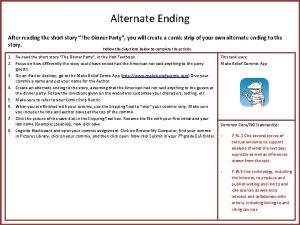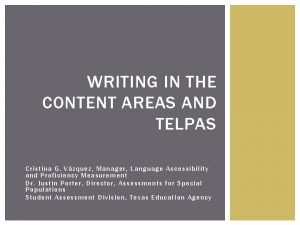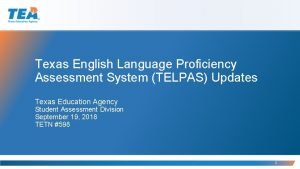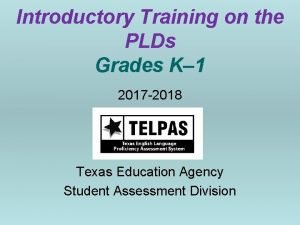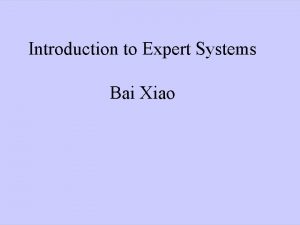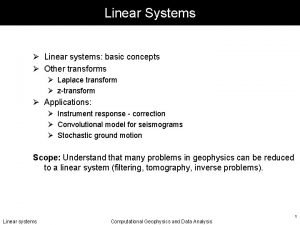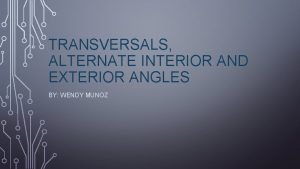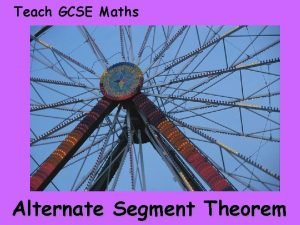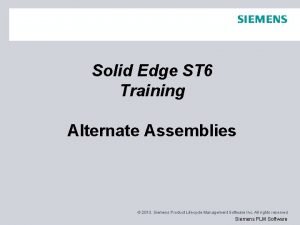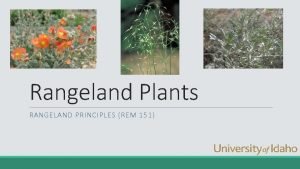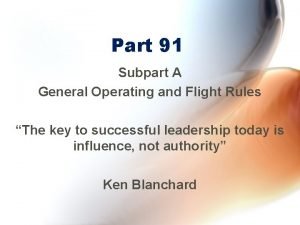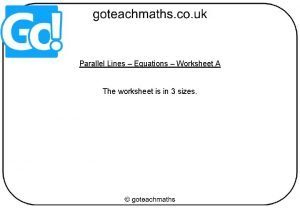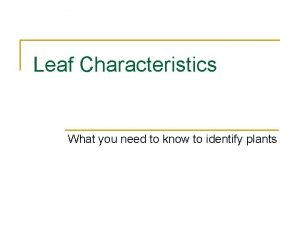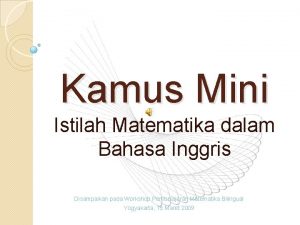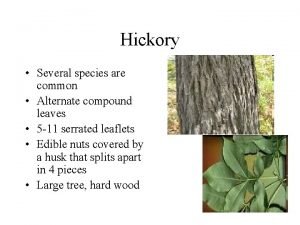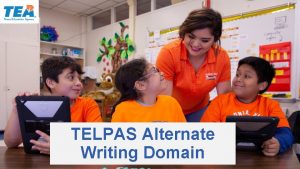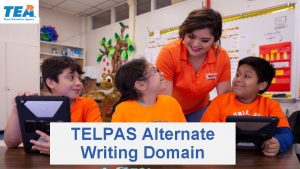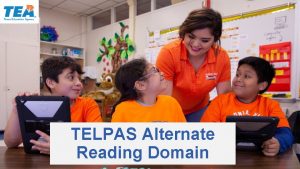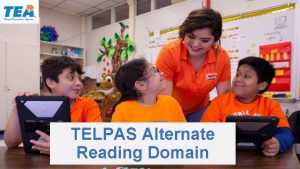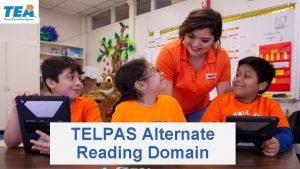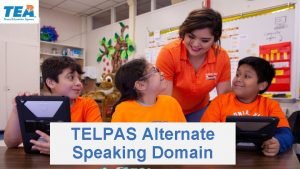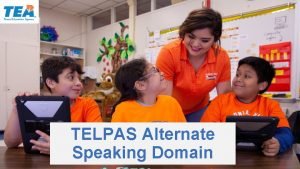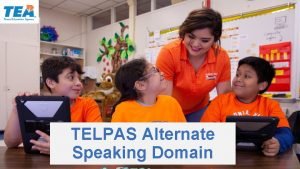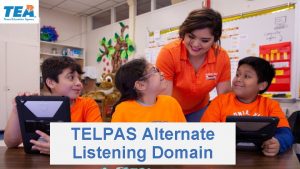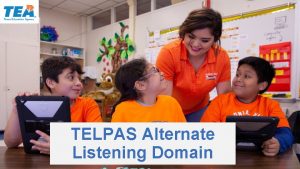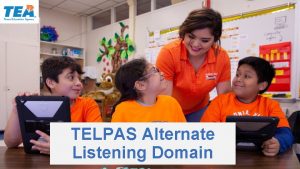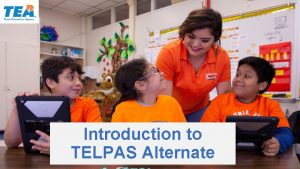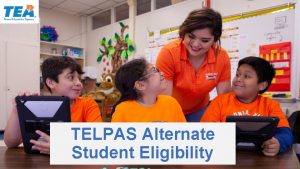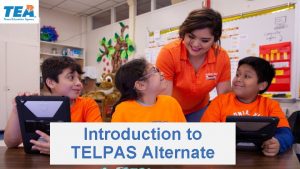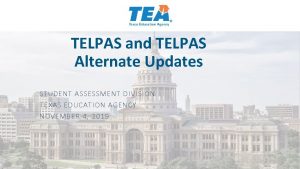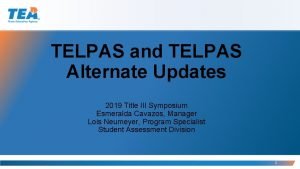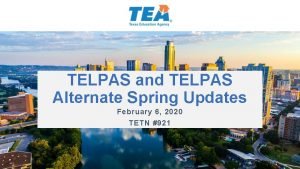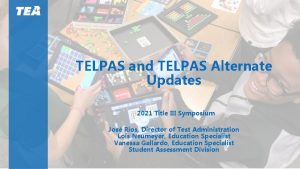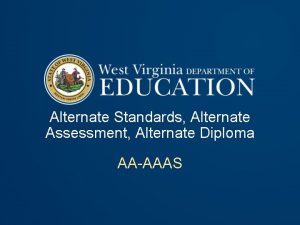TELPAS Alternate Writing Domain Purpose of this TELPAS

































- Slides: 33

TELPAS Alternate Writing Domain

Purpose of this TELPAS Alternate Training • Intended for classroom teachers who will be administering TELPAS Alternate during the testing window § Can be used by others (e. g. , test coordinators, administrators, parents) as needed in order to clarify different aspects of this testing program • Explains the Alternate Proficiency Level Descriptors and Observable Behaviors for Writing • Provides classroom examples of the Writing Observable Behaviors • Describes ways to make the Writing Observable Behaviors more accessible for students Student Assessment Division 2

Alternate Proficiency Level Descriptors • TELPAS Alternate is a holistic inventory aligned to the Texas English Language Proficiency Standards (ELPS). • This inventory is based on alternate Proficiency Level Descriptors (PLDs) that were created to address the specific access needs of English learners with significant cognitive disabilities. • The PLDs can be used to better understand the intent and scope of specific Observable Behaviors. • The PLDs can be used to provide a summary of a student’s general English writing ability after scoring. Student Assessment Division 3

Alternate Proficiency Level Descriptors: Writing *Students using augmentative and alternate communication (AAC) as expressive communication must use symbols that are combined with printed letters or words beginning with the “Early Independence” level. Student Assessment Division 4

Footnote to the Writing PLDs Starting with the “Early Independence” level, writing that students produce must involve letters or words. Students who use AAC that is programmed only with pictures or symbols cannot be rated above the “Imitation” level in this domain. The admission, review, and dismissal (ARD) and the language proficiency assessment committee (LPAC) should keep in mind that some students’ disability may prevent them from demonstrating full proficiency in writing and that those students will probably show strengths in other domains. Not all students will achieve the highest proficiency level in all domains. Student Assessment Division 5

What are Observable Behaviors? • In TELPAS Alternate, the Observable Behaviors are like questions the test administrator answers about a student. Each Observable Behavior measures one skill that is aligned to the ELPS. The skill can be found on the left under the number of the Observable Behavior. The boxes contain descriptions of characteristics that students learning English are likely to demonstrate over time. The descriptors show the progression of second language acquisition from one proficiency level to the next and are aligned to the TELPAS Alternate PLDs. • A “notes version” of the Observable Behaviors can be found on TEA’s TELPAS Alternate Resources webpage. It is available so that educators can become familiar with the Observable Behaviors and practice using them during the school year. Student Assessment Division 6

Observable Behaviors and the Glossary You may discover vocabulary in the Observable Behaviors that might be used in a way that differs from common classroom usage. The TELPAS Alternate Test Administrator Manual includes a glossary with terms specific to this assessment that may assist you. Student Assessment Division 7

Observable Behaviors with Classroom Examples • Texas teachers developed classroom examples to help test administrators better understand the descriptions of student performance for each Observable Behavior. • Elementary and secondary examples describe one way that students could demonstrate each skill across the five levels of proficiency. An accessible version of the Observable Behaviors and classroom examples can be found at https: //tea. texas. gov/student. assessment/telpasalt/#Alt Student Assessment Division 8

Using the Classroom Examples • The purpose of each example is to illustrate how a student could demonstrate the skill at each proficiency level. • There are many other classroom activities that could be used as examples for the Observable Behaviors. • These examples are not intended to be used as test questions or performance tasks for teachers to replicate, although using them for this purpose is acceptable if needed. • Teachers are encouraged to use their own activities in the regular classroom setting when determining a student’s ability to understand use English. Student Assessment Division 9

Observable Behavior W 1. Representing Sounds with Letters with Classroom Examples Elementary Student does not attend to teacher writing the letter of the day. Teacher holds up a card with a picture of a cat. Student attempts to write the letter c. Student writes the letters c and t when shown a picture of a cat and asked to write the word. Student writes the words “hat, ” “can, ” and “dog” during a spelling activity. Student writes the phrase “dog and cat. ” Secondary Student watches teacher writing first letter of the word “den. ” Student writes the letter b in an attempt to write the first letter of the word “den. ” Teacher says “den” and shows student a picture of a fox’s den. Student inserts letters d and n on whiteboard with “__e__. ” Student writes “fox, ” “den, ” “eat, ” and “food” after a science unit about animals and their habitats. Student writes the phrase “Lives in den and eat bird” after a science unit about animals and their habitats. Student Assessment Division 10

Observable Behavior W 2. Using New Vocabulary with Classroom Examples Elementary Student vocalizes while teacher writes the word “energy” on the board. Student tries to write the letter e to represent the word “energy. ” Student writes “enrgy” to represent the word “energy. ” Student writes “Sun givs enrgy. ” to describe a source of energy. Student writes “The sun gives lite energy to peple. ” to describe a source of energy on which people rely. Secondary Student watches other students writing the word “government” in their notebooks. Student writes g to represent the word “government. ” Student writes “gvnmtt” to Student writes represent the word “goverenmet help us” to “government. ” describe a function of government. Student writes “The goverenmet help people falo rules. ” to describe a function of government. Student Assessment Division 11

Observable Behavior W 3. Spelling with Classroom Examples Elementary Student will eye gaze at teacher writing his or her name below a picture of the student. Student attempts to arrange the magnetic letters of his or her name in order, when looking at a card with his or her name printed on it. Student writes “Lesa Mare” when attempting to spell her name “Lisa. Marie. ” Student labels one of his drawings about what he likes to do after school with the words “frend, ” “hows, ” “play, ” and “ball. ” Student writes in her journal in response to a prompt about what she did that weekend by writing “I went to store with my family. ” Secondary Student will attend to teacher writing the word “art” on the daily schedule. Student attempts to copy the printed word “art” on the schedule by typing “tar. ” Student types “pensl” when attempting to type the word “pencil. ” Student lists her favorite activities in art class by writing “draw, ” “pant, ” “color, ” and “glu. ” Student describes an activity in art class by writing “I make a model of my dog with clay. ” Student Assessment Division 12

Observable Behavior W 4. Spelling Patterns and Rules with Classroom Examples Elementary Student vocalizes while teacher shows and reads the word/picture combinations for “cat, ” “rat, ” and “hat. ” Student matches the word/picture combination of “cat” to “mat. ” Using a pocket chart, student sorts word/picture cards (bat, pat, sat, pig, fig, dig) into the correct word families of “at” and “ig. ” Student creates words in the “ig” word family by adding a letter card as the beginning sound to the ending “ig” (“big, ” “rig, ” and “wig”). Student identifies that the words “feat, ” “beat, ” “meat, ” and “heat” all end in “eat. ” Secondary Student looks at the floor while teacher shows and reads the word/picture combinations for “light, ” “fight, ” and “night. ” Student matches the word/picture combination of “light” to “right. ” Using a T-chart, student sorts word/picture cards (tight, sight, bright, snake, brake, lake) into the correct word families of “ight” and “ake. ” Student creates words in the “ight” word family by adding a letter card as the beginning sound to the ending “ight” (“fright, ” “height, ” “might”). Student identifies that the words “store, “chore, ” “tore, ” and “more” all end in “ore. ” Student Assessment Division 13

Observable Behavior W 5. Writing with Subject. Verb Agreement with Classroom Examples Elementary Student does not pay attention to a writing activity where teacher demonstrates an example of subject-verb agreement. Student matches the sentence strip with the text “The dog runs” to an identical sentence strip with the text “The dog runs. ” Student completes a cloze sentence by providing the correct verb tense. (Example: “The boy are/is playing ball. ”) When teacher reads aloud a student’s writing, student indicates that there is an error in subject-verb agreement. Student is unable to correct the error. When teacher reads aloud a student’s writing, student will stop teacher when there is an error in subject-verb agreement. Student will correct the error. (Example: “It should be ‘I run at recess, ’ not ‘I runs at recess. ’”) Secondary Student watches teacher demonstrate an example of subject-verb agreement on the board. Student matches the sentence “I am hungry” to an identical sentence “I am hungry” on a worksheet. Student completes a cloze sentence by providing the correct verb tense. (Example: “The sky look/looks cloudy today. ”) When student rereads her writing, she will indicate when there is an error in subject-verb agreement. Student will ask teacher how to revise it. When student rereads her writing, she will independently revise errors with subject-verb agreement. Student Assessment Division 14

Observable Behavior W 6. Verb Tenses with Classroom Examples Elementary Student tries to get his friend’s attention while teacher writes a sentence using past tense during the morning message. (Example: “Yesterday we baked a cake. ”) Student will find the card with the same past-tense verb as the verb in teacher’s sentence. (Example: Student puts the card “baked” on top of the word “baked” from teacher’s sentence. ) After teacher writes the words “mixed, ” “covered, ” and “baked” on the board, student arranges letter cards to write “mixd, ” “cover, ” and “baked. ” Student matches a picture of each event to the following phrases: “mixed the cake, ” “covered the cake, ” and “baked the cake. ” Student writes “I liked the cake” on the board. Secondary Student vocalizes while teacher writes a sentence using past tense during a science lesson. (Example: “We planted seeds in a pot yesterday. ”) Student will find the card with the word “planted” and place it on top of the word “planted” in teacher’s sentence. After teacher writes the words “planted, ” “used, ” and “watered” on the board, student writes “plant, ” “uze, ” and “waterd” on whiteboard. Student matches a picture of each event to the following phrases: “planted the seeds, ” “used the hose, ” and “watered the dirt. ” Student writes “This morning I pulled weeds” in his science journal. Student Assessment Division 15

Observable Behavior W 7. Using Negatives with Classroom Examples Elementary Student vocalizes or eye gazes when teacher writes “I do not like rain. ” Student sorts picture/ sentence cards into groups of “I like” or “I do not like” on a pocket chart. (Example: Picture/ sentence card with “I do not like bugs” goes under the “I do not like” part of the pocket chart. ) Student completes the sentence stem “I do not like ___” by writing the word “snakes. ” Student writes “not like nap” in his journal. Student writes “I do not like gym class. I do not like to jump rope. ” Secondary Student nods and gazes when teacher writes “We don’t run in the hall” during a lesson about class rules. Student sorts picture/ sentence cards into groups of “Do” and “Don’t” on a graphic organizer. (Example: Picture/ sentence cards with “We do listen” and “We don’t yell. ”) Student completes the sentence stem “We don’t ___” by writing the word “hit. ” Student writes “don’t lie” on the board during a lesson about class rules. Student writes “In our class we don’t hurt others. We are friends that help each other. ” Student Assessment Division 16

Observable Behavior W 8. Connecting Words with Classroom Examples Elementary Student listens as teacher describes the lunch menu: “Today, we are eating chicken nuggets and mashed potatoes. ” Student matches a word/picture card for “milk” and a word/picture card for “cookies” with a single word/picture card of “milk and cookies. ” After being asked about two things she likes to eat, student writes “grapes and chips. ” After being asked what he ate for breakfast, student writes “ate eggs and drank milk. ” Student combines the two sentences “I like to eat pizza” and “I like to eat chicken nuggets” by writing “I like to eat pizza and chicken nuggets. ” Secondary Student puts head on desk as teacher writes about the weather: ”This morning the weather is sunny but cold. ” Student places a word/picture card for “sunny” and a word/ picture card for “cold” on either side of “but” in the teacher’s sentence. Student writes two different words to describe the weather and connects them with “but. ” Student describes the weather by writing “cold outside but warm inside. ” Student writes “The weather is cold outside but warm inside. ” Student Assessment Division 17

Observable Behavior W 9. Narrating with Classroom Examples Elementary Student watches teacher write about a trip to the beach. Secondary Student ignores the Student incorrectly teacher as the teacher labels pictures that writes about his weekend. show activities that she did over the weekend. Student incorrectly labels pictures that show the steps a girl took to build a sandcastle. Student labels three pictures that show the steps a girl took to build a sandcastle (Example: “dg” for “dig, ” “water” for “add water, ” and “pet” for “pat the sand. ”) Student writes about a day at the beach with the phrase “fun with sand. ” Student writes about a day at the beach: “I go to beach with mom. It is fun and sunny. ” Student labels three pictures that show activities he did over the weekend (Example: “TV, ” “cuk” for “cook, ” and “plae” for “play. ”) Student writes about his weekend with the phrase “watch TV show with mom. ” Student writes about his weekend: “I watch TV with mom. I cooked with mom and played outside. ” Student Assessment Division 18

Observable Behavior W 10. Descriptive Language with Classroom Examples Elementary Student watches other students write descriptions of their favorite animals. Student scribbles on paper in an attempt to describe a dog. Student writes “nic” (nice) to describe a dog. Student writes “nic an bown” (nice and brown) to describe a dog. Student writes “A dog is happy and fun. A dog runs fast. ” Secondary Student watches other students write descriptions of Martin Luther King, Jr. Student scribbles on paper in an attempt to describe Martin Luther King, Jr. Student writes “bav” (brave) to describe Martin Luther King, Jr. Student writes “was smart an nic” (was smart and nice) to describe Martin Luther King, Jr. Student writes “He was a brave and smart man. He said the rite thing even if it was hard” to describe Martin Luther King, Jr. Student Assessment Division 19

Additional Classroom Examples • Additional classroom examples were created for some of the Observable Behaviors. • The TELPAS Alternate Observable Behaviors and Classroom Examples (Accessible) PDF, which includes the additional classroom examples, can be found on the TELPAS Alternate Resources webpage. Student Assessment Division 20

How to Determine Student Proficiency for Each Observable Behavior 1. Test administrators should consider only one Observable Behavior at a time. 2. Test administrators will read the skill and think about recent opportunities the student has had to practice that skill. Then test administrators will read the five descriptions of student performance for the Observable Behavior and use their current knowledge and observations of the student’s English language skills to make individual holistic judgments. Student Assessment Division 21

How to Determine Student Proficiency for Each Observable Behavior, continued 3. Test administrators must consider the ability of each EL to use English in the domain of writing in the context of skills the student is learning and practicing in a classroom setting. § Think about how well the student has demonstrated the ability to understand or use English in the context of skills the student is learning. § Think about how well the student is able to understand or use English when practicing these skills in a classroom setting. 4. Select the description that closely matches the student’s performance most consistently. § Consistently: almost always acting, behaving, or responding in the same way Student Assessment Division 22

On the Border • There is an early, a middle, and a late stage within each TELPAS Alternate proficiency level. Students in the early stage of a proficiency level might demonstrate language that drops down into the previous level at times, especially when working with academic language or new vocabulary and language structures. • Similarly, students in the late stage of a proficiency level will sometimes demonstrate language that reaches into the next level. • For each Observable Behavior, test administrators must consider the description that applies to each student most consistently. Demonstrating a new skill once or even occasionally does not mean a student has crossed over into a higher level of proficiency. Student Assessment Division 23

Collaboration • For students who are in the very early or very late stage of a level, it is recommended that test administrators § collaborate with others or ask others familiar with the students for input, and § wait until later in the assessment window to see whether a couple of additional days of observation will help clarify the most appropriate description. Student Assessment Division 24

Example of Rating a Student “On the Border”: Sihtu Mr. Ríos is considering the progress that his student Sihtu has made this year in writing narratives. He looks over his notes (see below). He sees that Sihtu began the year consistently performing at the third level. Even though Sihtu has made significant progress and is peaking into the next level, Mr. Ríos determines that Sihtu’s performance is not consistent enough at this level. He marks the third level for this Observable Behavior. Student Assessment Division 25

Example of Rating a Student “On the Border”: Deniz The TELPAS Alternate administration window is open. Mr. Kiang has been gathering information about one of his students, Deniz. Mr. Kiang refers to some notes he has made about Deniz’s progress using past-tense verbs. At the beginning of the year, Deniz was starting to use some simple past-tense verbs such as “walked” and “played” in short phrases, but she struggled with irregular past-tense verbs such as “went, ” “ate, ” and “ran. ” Teachers who work with Deniz have been working with her on this skill and are seeing improvement. Mr. Kiang looks at some of Deniz’s written work from the last month. Over the last two weeks, he is seeing consistent use of a variety of past-tense verbs in sentences and longer phrases. He sees “I went to the stor and got a cany” and “I ran to clas becus I was layt” in journal entries. Mr. Kiang determines that Deniz is consistently demonstrating the ability to use past-tense verbs at the highest level. Student Assessment Division 26

Alternate Response Modes • For TELPAS Alternate, “English” is more inclusive to allow for all modes of communication in English. • Some English learners use sign language, braille, or another method of communication as a substitute for traditional English in one or more language domains. • Test administrators should allow students to use one or more alternate response modes on the following slide if the students regularly use the response mode(s) during instruction and in accordance with the individualized education program (IEP). • Alternate response modes are only intended for students who cannot listen, speak, read, or write in a traditional way. They are intended to address the communication needs of students based on their disability. Student Assessment Division 27

Allowable Response Modes for the Writing Domain For the writing domain, it is allowable for a student to § § § write alert to gaze at point to reach for touch or pick up draw circle nod gesture toward the targeted stimulus use adaptive writing equipment (typing, keyboarding) arrange letters, words, or numbers to form a response when a wide range of manipulatives are available Student Assessment Division 28

Augmentative and Alternative Communication • Augmentative and Alternative Communication: a means other than traditional spoken or written communication by which a student can share a message with others. • Examples include but are not limited to: § § § § gestures facial expressions picture cards picture boards sign language speech-generating devices switch-based output devices real objects Student Assessment Division 29

Prompting Versus Leading • • • Prompting is an action intended to initiate or continue a task that the student is being requested to complete. A prompt pulls the student through each step to the end of the task. Leading is asking the student to respond in a specific way or with a specific answer. Leading is NOT allowed. Prompting is allowed for rating the Observable Behaviors on the TELPAS Alternate assessment. § The purpose of TELPAS Alternate is to accurately measure a student’s ability to understand use English to engage in social and academic learning environments. § Prompting a student to respond to a task so that his or her ability to understand or use English can be accurately measured is acceptable. Student Assessment Division 30

Available TELPAS Alternate Training Power. Points q Introduction to TELPAS Alternate q Reading Domain q Writing Domain q Student Eligibility q Accessibility q Listening Domain q Test Administration q Speaking Domain Student Assessment Division 31

Contact Information TEA’s Student Assessment Division 512 -463 -9536 Help Desk Helpdesk. tea. texas. gov Pearson’s Customer Service Center 800 -627 -0225 Tx. Pearson. Access@support. pearson. com Student Assessment Division 32

Disclaimer These slides have been prepared by the Student Assessment Division of the Texas Education Agency. You are encouraged to use them for local training. If any of the slides are changed for local use, please hide or remove any TEA logos, headers, or footers. (You may need to edit the Master slide. ) In addition, you must remove the photographs. Only TEA has parental permission to use these photographs for training purposes. This training is not intended to replace any materials or additional information on the TEA website. Student Assessment Division 33
 Telpas alt plds
Telpas alt plds Short story alternate ending assignment
Short story alternate ending assignment Telpas writing types
Telpas writing types Telpas 4 point speaking rubric
Telpas 4 point speaking rubric Telpas writing samples 2020
Telpas writing samples 2020 Telpas descriptors
Telpas descriptors Domain codomain range
Domain codomain range Z domain to frequency domain
Z domain to frequency domain Fourier series of trapezoidal waveform
Fourier series of trapezoidal waveform Time reversal z transform
Time reversal z transform Z domain
Z domain Domain specific vs domain general
Domain specific vs domain general Domain specific vs domain general
Domain specific vs domain general Problem domain vs knowledge domain
Problem domain vs knowledge domain S domain to z domain
S domain to z domain Language processor mcq
Language processor mcq What is a sentence purpose
What is a sentence purpose General purpose specific purpose central idea
General purpose specific purpose central idea Alternate form of reliability
Alternate form of reliability Wendy angles
Wendy angles Proof of alternate segment theorem
Proof of alternate segment theorem Solid edge alternate assemblies
Solid edge alternate assemblies Common curly mesquite
Common curly mesquite Rima baciata
Rima baciata Vfr minimums
Vfr minimums Corresponding alternate and co-interior angles worksheet
Corresponding alternate and co-interior angles worksheet Alternate exterior angles
Alternate exterior angles Deciduous vs coniferous
Deciduous vs coniferous Scalloped leaf margin
Scalloped leaf margin Rime alternate
Rime alternate Allitterazione
Allitterazione 100 istilah matematika
100 istilah matematika Nwkraft far aim
Nwkraft far aim Water oak leaves
Water oak leaves
